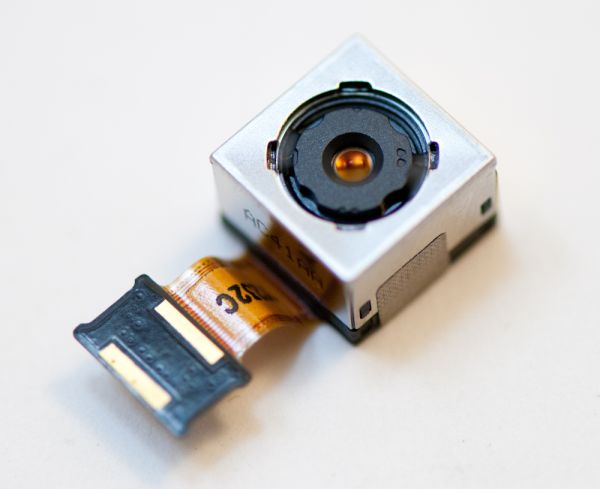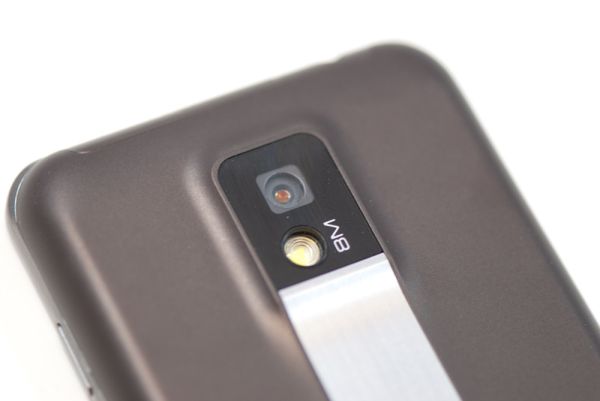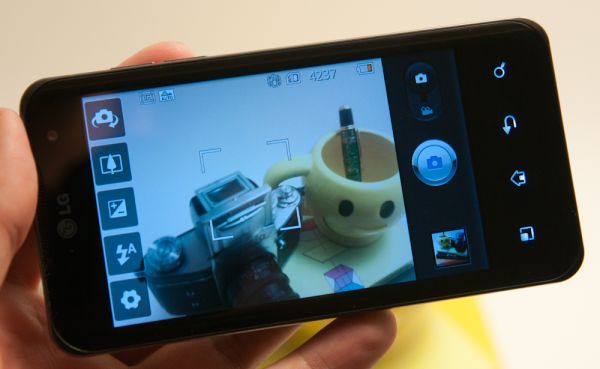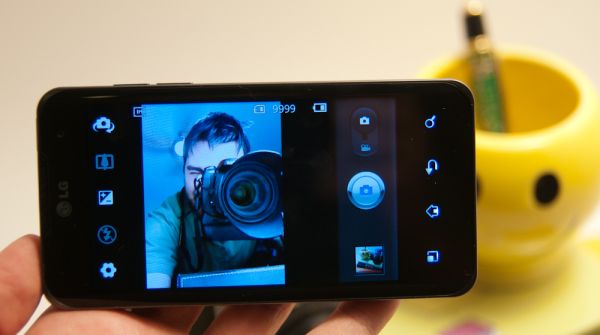LG Optimus 2X & NVIDIA Tegra 2 Review: The First Dual-Core Smartphone
by Brian Klug & Anand Lal Shimpi on February 7, 2011 3:53 AM EST- Posted in
- Smartphones
- Tegra 2
- LG
- Optimus 2X
- Mobile
- NVIDIA
Camera Analysis
The 2X has a 1.3 MP front facing camera and 8 MP rear camera, unfortunately I haven’t been able to determine the camera source, but pixels on the rear camera are 1.4 µm square, and 1.75 µm on the front facing camera. That pixel size would make the 2X’s CMOS sensor most likely 1/3.2” in size.

The LG Optimus 2X's 8 MP rear facing camera
LG’s camera app is familiar territory coming from other LG Android phones. We’ve still got the LG Optimus One, which has almost the exact same layout and design camera application. Honestly, I think LG’s got the best menus I’ve seen yet for a smartphone. There are image size settings for 8 MP (3264x2488), 5 MP, 3 MP, 2 MP, 1 MP, VGA and QVGA, three compression settings (Super Fine, Fine, and Normal), some optional focus controls (Auto, Macro, Face Tracking, and Manual Focus), ISO (Auto, 100, 200, 400, 800), scene modes, effects, ability to disable the shutter sound, and the shot mode. There’s the option of recording images either on the “internal SD card” (which is really that eMMC) or an external SD card if you’ve got one inserted. I noticed that writing to internal storage enabled a bit faster cycling between images compared to my SD card. There's a full overview of all the camera and video capture settings in the gallery below.
Shot mode is interesting because under it is a setting called “continuous shot” which enables 6 photos to be captured in rapid succession, which you can see in action in our overview video. When switching to that mode, image size drops from 8 MP to a maximum of 2 MP, and a couple of other options grey out. Tapping the capture button immediately takes those 6 images in rapid-fire succession and saves them. It’s cool that you can take a bunch of images quickly, but what would be more useful is being able to mash the capture button in the normal shooting mode and capture as quickly as you would on a decent DSLR. That still isn’t possible, but we’re clearly getting there. NVIDIA advertises that its image signal processor (ISP) is capable of doing 12 MP at 11 FPS, and JPEG encoding at 80 MP/s, which would mean that (negating integration time on the camera sensor) 10 FPS shooting should be possible. That’s obviously a bit ambitious, and isn’t what we see here—maybe someday though.
The OSD LG has put together for the camera is again probably the best I’ve seen on any Android—heck smartphone in general—yet. Icons rotate between landscape and portrait orientation modes, up at the top are shots remaining, image size, and other iconography for modes that have been set elsewhere in settings. Tapping or waiting a few seconds eliminates everything save the live preview to give a less cluttered view for image composure. The 2X lacks tap to focus and expose, instead it’s always center-weighted. There’s also no dedicated capture button on the 2X, so the on-screen button is the only option.
Image quality from photos taken with the rear facing camera is actually pretty good. There’s a lot of spatial detail in our test images with surprisingly little noise. I’d say that the 2X actually takes some of the best 8 MP smartphone images I’ve seen to date. The problem, however, is saturation. Colors are almost universally under-saturated by default—compare almost any of the shots we took at our bench location to other devices, and it’s readily apparent. It’s still outclassed by phones like the Nokia N8, but not bad.
With the lights off, the 2X runs autofocus with the LED lit up, which is awesome. Unfortunately, the flash exposure over illuminates our test scene and creates a very overexposed image. Otherwise the LED flash is nice and powerful, yet more proof that having two isn’t necessarily better.
Interestingly enough the other strong suit of the 2X is that the preview image is one of the most fluid and high framerate we’ve come across. In situations with adequate light, the rear facing camera preview is easily higher framerate than the iPhone 4. Oddly enough, the front sensor preview framerate is quite low unless you’re imaging something extremely well-lit. The limitation on the front-facing camera framerate is one of integration time on the sensor rather than ISP bandwidth, however.
Tapping the top left button switches to the front facing camera. What’s odd however is that the front facing camera is actually rotated 90 degrees. That’s not to say that the image is rotated 90 degrees, but rather that the longer side of the sensor is parallel to the shorter axis of the phone. The result is that there are black bars on both sides of the preview. It’s as if the sensor was aligned with the intention of being used with the phone primarily in portrait—instead of orienting the sensor to match the aspect ratio of the phone. It’s just an odd choice considering all the other smartphones we’ve looked at thus far are the other way around.
The 1.3 MP front facing camera can capture at 1280x960, VGA, and QVGA resolution. Quality isn’t too good—there’s noticeable lack of detail and blurring in our test image. It’s likely more than enough quality for a video chat that’s going to crop and decimate image size to a much smaller size. The 2X also mirrors images horizontally on the front facing camera.






































75 Comments
View All Comments
Exophase - Monday, February 7, 2011 - link
Thanks Anand.I'm surprised to hear that shot was from IMG, given that it was an IMG employee who made the comment originally about Tegra's 16-bit banding being evident on it, from the screenshot. Whoops. I do wonder what could be causing this, then.
Nonetheless, while that definitely makes my 16bit color claim invalid the depth buffer one should still hold. We might need to wait and see how much of a difference this actually makes, or rather how effective nVidia's 16-bit depth space is.
I'm glad to hear that you're as concerned about benchmarks on Android as I am. It's especially frustrating when I see people using them to try to indicate Atom being substantially better clock for clock than Cortex-A9.
Exophase - Monday, February 7, 2011 - link
Managed to miss this:"The test ramps from around 3k vertices to 15k vertices per frame, and 190k to 250k triangles per frame"
That line doesn't make any sense. How would you have hundreds of times more triangles than vertices? You must have meant something else.
sid1712 - Monday, February 7, 2011 - link
Great review as usual but i'm disappointed about the lack of details on the Sound Quality of the phone. A comparison of the sound quality (via headphone jack) alongside the iPhone 4 and the Galaxy S (with Voodoo kernel preferrably) would give a good idea about the SQ of the phone.ScentedKandle - Monday, February 7, 2011 - link
Related to this, the audio codec lists "lossless" but doesn't mention what format. Can the audio chip natively decode FLAC?teldar - Monday, February 7, 2011 - link
The order of buttons if the same as my droid x.Pjotr - Monday, February 7, 2011 - link
Does it really record 1920x1088? Does this unorthodox resolution play well on TVs, if you put it on a USB stick, for example?Brian Klug - Monday, February 7, 2011 - link
It plays back from the phone properly, and most of the playback software just does a crop. A ton of devices actually produce 1088 and don't make note of it, it should playback fine.-Brian
unmesh - Monday, February 7, 2011 - link
For active aka switching transistor power consumption, C*V^2*f (C is capacitance and f is frequency) is a better proxy than V^2/R.The conclusion that operating voltage has a huge effect remains the same.
Kevin098 - Monday, February 7, 2011 - link
Hey, can you make a video comparison between the iphone 4 retina display and Optimus 2x ?StormyParis - Monday, February 7, 2011 - link
Pages and pages of (apparently not very acurate, too) perf data, and not even one line on sound quality, which is one of my key buying points for a phone.No info on whether I'll be able to stream PC-resolution videos off my server to my bed over wifi.
Overall, not a very useful review. More like a dick size contest.